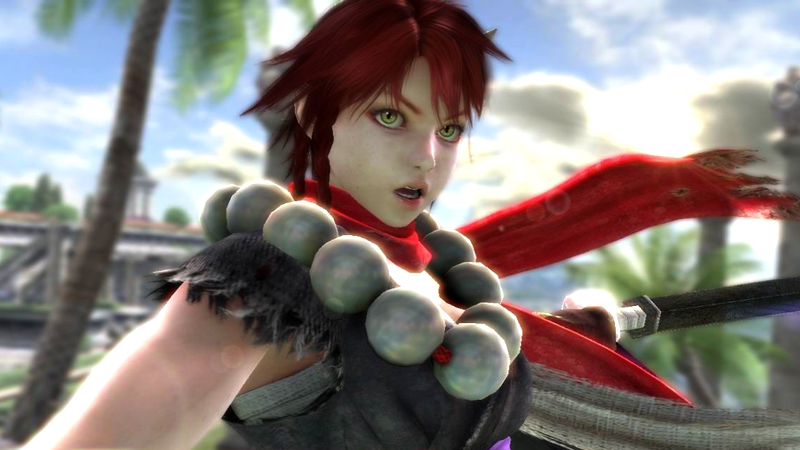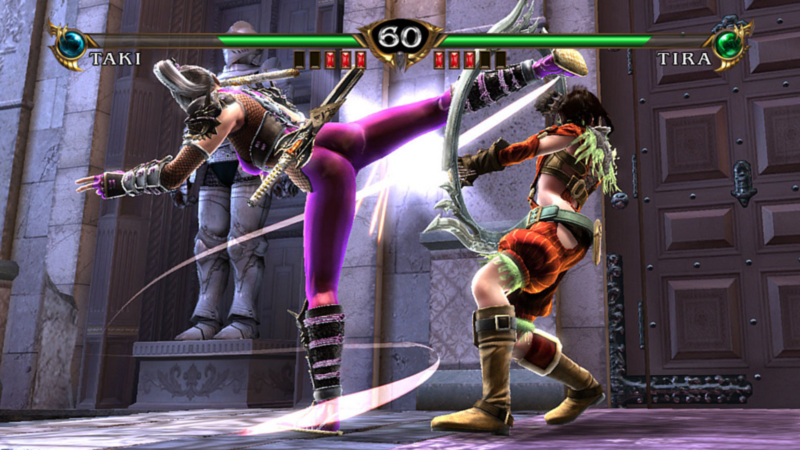or what seems like a genre in which very few titles, and even fewer of quality, release during a calendar year — Soul Calibur IV has come to breathe some life into the digital dojo dwellers out there. Soul Calibur IV, actually the fifth title in the series (if you count 2007's Soul Calibur Legends), brings back old faces from previous iterations as well as brand new characters. The Soul series is well known for its weapons-based combat system, and was an early example of fighting games that allowed you to circle your opponent on a three dimensional plane. Everything you loved about the series has returned, as well as another visit to the plastic surgeon for Ivy.

Amy — quickly becoming a
favorite amongst fans.Soul Calibur IV is a very full experience. I think "full" is honestly the best way to describe it in that there is so much to do. I think I spent about two hours with other features before I even fought one round, mainly reading through all the character's stories and how they connect to each other. The individual stories are still in place, along with the disembodied voice whose announcements still make no sense whatsoever. I've always found it odd that the story mode in these games actually constitute a "story." When you pick a character you are greeted with a few paragraphs of text that are fairly cryptic and vague, then you get a fifteen second cutscene at the end along with another sentence or two to wrap things up. They're brief to be sure, but they're not unwelcome, and you're probably not playing this game for any literary reasons.
During battle you have what is called a Soul Gauge, which fills when you land attacks, and depletes when you take damage. When your Soul Gauge is in the red, you are in a state called Soul Crush, in which further blocking of an enemy's attacks may be moot. You are also at risk of a piece of your armor breaking at this point. If you manage to completely empty an opponent's Soul Gauge, you will have a brief moment in which you can perform a Critical Finish, yielding an instant knockout. In addition, every character has a unique Critical Finish.

Vader's apprentice brings the
power of the Force to the arena.Also, at certain times, you have the ability to swap your character in and out with another. This is nothing new to the genre, but it does add an element of strategy to your fights. However, I do take issue with one aspect of this feature. In what basically feels like an exploit, if you are fighting an opponent, and have taken damage while whittling away your enemy's health, you can swap in your other character, finish off your opponent and get a perfect for the round if that character remains untouched. Ignore the fact that your other character took all kinds of damage. Since perfect rounds get you more points for unlockables, and also have an achievement associated with them (which I subsequently earned in about thirty minutes doing this), being able to get them so easily detracts from the challenge that getting a "perfect" is supposed to be.
This is really my only gripe with combat. While it's easy at times to get off-target from all the flashy moves and strafing, this is more a result of lack of practice than a failure of function. Characters feel balanced, and though there are some obviously better characters (Amy is quickly becoming a fan favorite), with the biggest roster in a Soul game to date you're sure to find a character that fits you.
I'm really fond of newcomer Hilde. A knight from the Kingdom of Wolfkrone, Hilde comes to battle with a short sword and spear. This is a fairly unique form of dual-wielding that grants Hilde long and short-range capabilities as she will switch between weapons depending on her proximity to her opponent. Fun to play, though I can't help feeling like she was modeled after Angelina Jolie.
Another contender, which many fans looked forward to, was Yoda in the Xbox 360 version; Darth Vader in the PS3 version; as well as Vader's secret apprentice from the upcoming Star Wars: The Force Unleashed in both. While I have yet to play with Vader, I have played with Yoda. He fights just as he did in the scene from Star Wars Episode 2: Attack of the Clones against Count Dooku.
Translation: lots of bouncing. Chances are that Yoda will either strike you as a great addition, or a cheap character that you can't hit. I'll leave that decision to you. Personally, I find characters like Taki to be much cheaper.
Another feature of note is the return of the character creator. After choosing what existing character's style your new warrior will be based on, the real fun begins. Just about any aspect of the character you can think of can be altered. Physique, musculature, eye color, hair color, skin tone, voice style and pitch, face shape, and pose are just some of the options. Tweaking armor and weaponry is the name of the game here, especially if you're going to play online. In a system reminiscent of Chromehounds, every piece of armor and weaponry has statistics that affect your overall health, offensive, and defensive abilities. More items are unlocked as you play, and can be purchased in the creator, which translates to innumerable item combinations. The likelihood that you'll run into your twin online is very low. I love whenever a game gives me customization options, because it extends the life of the game, and allows for experimentation that keeps a game from getting to linear. Editing the appearance of the established characters is even an option available to you.

There are many new characters
to unlock in Story Mode.You can also add abilities to your character that have an affect in combat. Such abilities give health back after x amount of hits, or add venom to attacks, etc. How you manage these in addition to the gear you give your character can have a profound affect on your success online. But to those of you who are only concerned with aesthetics, do not worry. There are two different online fighting modes, one which takes armor stats and abilities into account, and one that does not (this mode balances the scale). So there is a way to play no matter what your preferences are. In addition you can set up private rooms for you and your friends online.
Visually, Soul Calibur IV is obviously the best looking game in the series, but I would even wager that it is the best looking fighting game to date. The colors and lighting are extremely vivid and bright, without being overwhelming. Individual characters are unique in their visual presentation, and each has a great degree of detail in their faces, armor, and weaponry. Unique characters have been a mainstay of the Soul Calibur series, and it's why I feel many of them are so memorable. Swords spark as the meet in the air, rock breaks as combatant falls hard to the ground, and armor shatters under constant abuse. Yoda and Vader are spot on in their appearances too. Fighting grounds are as unique and well realized as the combatants are. Whether you are fighting high atop a mountain, on a raft floating along the river, at night or during the day, the arenas you'll fight in are as much fun to look at as the characters are. It's not all perfect though. The character lip-syncing is really off, and the opening movie is pretty tame and does little to excite you. Those aside, Soul Calibur IV isn't just a solid game, it's really pretty to look at.

Combat is fast, fluid, and brutal.In recent years, I've really tried to pay attention to the sound design of games. More often that not, gamers simply don't notice the work that goes into creating the audio for their favorite games. Well, the sound for Soul Calibur IV isn't bad, but it's not extremely memorable either. The thing is, how do you create memorable sound design for a fighting game? That's not rhetorical. I'm really asking. The majority of the game sound is the clanking and clashing or weapons, grunting and yelling from characters, and environmental music. While they are very well done here, nothing about them made me think later about them later. Many of the sounds seem as though they are simply holdovers from previous Soul games, or are simply remixed a little. I don't really know if I can fault the game for this. If anything, it has caused me to consider this as separate topic. What roles does sound play in a fighting game, and how can it be made memorable? Maybe we'll discuss this later. Character voices are varied, though they all speak in vague short sentences at the beginning of every fight, just as the announcer's voice does. It's just kind of weird, and can be a head-scratcher. To sum up, the sound is well constructed, but won't stay with you when you walk away from the console. Again, is this a product of the genre?
In the end, Soul Calibur IV is a quality fighting game. If you are fan of the series, as I am — and I generally don't play fighting games — you'll be right at home here with enough new features to satisfy. If you're new to the fighting genre, it's a great game to start with. It has different difficult settings, as well as tutorials and move lists to help you learn a character or two to be competitive with. With the ability to customize a unique character, purchase high quality illustrations, unlock unique items in the Tower of Lost Souls mode, and much more — Soul Calibur IV is a game that delivers on all fronts. It's not perfect, but it's pretty close. Whether you favor the sword or the staff, axe or the rapier, or even a lightsaber, Soul Calibur IV is easily the fighting game of the year.










































